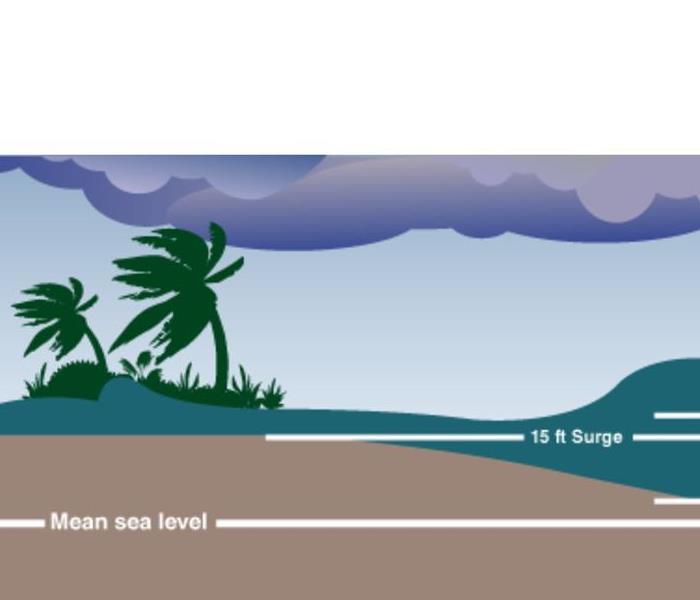Storm Surges
11/22/2018 (Permalink)
So what is storm surge, how and why does it happen and why should you be wary of it and heed warnings?
Well for starters, storm surge happens when water is pushed onshore by a hurricane.
A storm surge forms as the ocean water is pushed by winds and waves, and is also sucked into the air near the eye of the hurricane by low pressure. AJC.com suggests that you should imagine a bowl of water. Put your hand in the middle of the bowl and cup it. Now slowly push your hand toward the edge of the bowl. Those are the same dynamics as storm surge.
While it can be confused as such, a storm surge is not a wall of water that rushes in onto the shore. It is typically a rise of water which often happens quickly, moving at the same rate as the forward speed of a hurricane.
Surges are very powerful!! Only 1 cubic yard of sea water weighs 1,728 pounds. A 6-inch surge can knock a person down. It can and will take out and destroy things in its path due to either force and/ or a combination of force and pressure from flood water.
Storm surges kill more people in a hurricane than any other components of the storm. It is for this reason alone that it is always encouraged to evacuate from areas along the shore, or from smaller islands where there isn’t much inland area to seek what’ll remain as dry land. The overwhelming majority of deaths which are in part of the 10 deadliest U.S. landfalling hurricanes were the result of storm surge alone.
Get away from storm surges. Your life, your families lives, your pets lives depend on it. It isn’t worth the risk to take your chances and stay behind. Especially when evacuation orders are in place. While yes, meteorologists can predict wrong, it’s often only due to how unpredictable these storms can sometimes be. Safety and evacuation measures should be taken and obeyed though as it’s not recommended to gamble with your life. First responders lives are then also placed directly in jeopardy when having to go in to rescue those who choose to “ride out the storm” by not evacuating.
A surge 1 foot deep can take a car off a road. Getting out early is key because the surge can begin up to 24 hours before the storm makes landfall. According to AJC.com during Hurricane Katrina, people stayed in their homes and died there when the surge filled their homes with water and they could not escape. Also, don’t leave pets at home. Many animals died when people left them in their homes during Hurricane Katrina.
What does a 9-foot, 10 -foot etc storm surge mean?
According to AJC.com It depends on the sea level at the point where the water begins “The storm surge is how high above current sea level the ocean water gets. The number we are most interested in regarding storm surge is how many feet above mean sea level (MSL) inundation will occur. This number is known as the storm tide ... The storm tide is the height of the storm surge above the MSL, corrected for the tide.
“For example, in a location where high tide is 2 feet higher than mean sea level, and low tide is 2 feet lower than mean sea level, a 15-foot storm surge would cause a 17-foot storm tide if the hurricane hit at high tide or a 13-foot storm tide at low tide."
Storm surges are going to cause flooding to your home whether you are in it or not. Again it is best to evacuate and in a timely manner. Once it is deemed safe to return to your home, it is then that SERVPRO is here to assist. We are here to assist not only with flooding due to storm surge or lots of rainfall, but also with storm damage resulting from high winds. Give SERVPRO Greensboro North a call 24/7 and if we are not nearby, we will be able to connect you with a SERVPRO in your direct area.






 24/7 Emergency Service
24/7 Emergency Service
